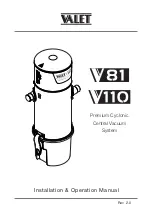
33
32
ENGLISH
ENGLISH
CONGA 990 VITAL
CONGA 990 VITAL
5. CLEANING AND MAINTENANCE
In order to lengthen your robot’s shelf life and to allow your robot to operate at peak
performance, carry out the following procedures periodically.
Emptying the robot’s dust tank
Press the dust tank’s release button.
Open the dust tank and empty it.
Fig. 41.
Cleaning the robot’s High-efficiency filter
Remove the high-efficiency filter.
Carefully shake off all dust from the High-efficiency filter.
Fig. 42.
Cleaning the free-fall sensors
Use a clean, dry and soft cloth to wipe off any dust from the free-fall sensor located on the
right side of the robot’s bottom part.
Fig. 43.
Warning: Do not spray cleaning products directly on the sensor.
Clean the main brush.
Fig. 44.
Slightly press the main brush frame’s tabs in order to open the main brush storage gap and to
remove it.
Remove any hair, fluffs or dust collected in the brush and around the axes.
Fig. 45.
Clear and clean the robot’s suction channel.
Fig. 46.
Reinstall the main brush and its frame.
Fig. 47.
High-efficiency filter
The high-efficiency filter is designed with fibres that help trapping dust particles, dust mites,
pollen... It is very important to clean periodically the filter, to avoid this particles from building
up in the filter, causing efficiency loss. It is convenient to carry out this maintenance once a
week.
It is suggested to replace the filter by a new one after a maximum of 160 hours of use.
Recommendations:
Dirt can be removed with a small brush or by shaking it carefully against a hard surface for
dust to fall off. The high-efficiency filter cannot be washed.
Mesh primary filter and sponge filter
The filtering system is featured with a mesh primary filter and a sponge filter. It is suggested
to replace them either after a maximum of 160 hours of use or when they are worn out due to
operation.
Recommendations:
Dirt can be removed with a small brush or by shaking it carefully against a hard surface for
dust to fall off. You can also use warm water without detergents to obtain better results.
Always make sure they are completely dry before installing them again.
Side brushes
Side brushes are designed with multiple bristles and are used to push dirt towards the suction
nozzle and to clean thoroughly edges and corners. These brushes can wear out over time,
affecting negatively to the cleaning efficiency. For this reason, it is suggested to replace each
side brush after a maximum of 220 hours.
Recommendations:
It is recommended to clean the side brushes once a week with the help of the cleaning brush.
Main brush
The main brush is designed with bristles and silicone, spins at top speed and helps introducing
dirt into the suction nozzle. This brush is in contact with the floor, and therefore with dirt, so it
can be worn out over time, affecting negatively to the cleaning efficiency. For this reason, it is
suggested to replace each side brush after a maximum of 320 hours.
Recommendation: It is recommended to clean the main brush once a week with the help of the
cleaning brush.
Sensors
Cleaning robot vacuum cleaners have different types of sensors, for example, proximity
sensors that allow the robot to move around while detecting obstacles or free-fall sensors
that help the robot to detect slopes or possible gaps/unevenness such as staircases. These
sensors are always in contact with dust particles, and therefore can be blocked over time,
causing possible navigation errors. is suggested to clean all the robot’s sensors with the
cleaning brush or with a dry cloth after a maximum of 35 hours of operation.
6. BATTERY CHARGE AND REPLACEMENT
Fig. 48.
To lengthen the battery’s service life, keep the robot charging on the charging base when not
















































